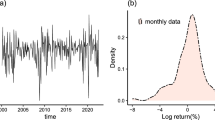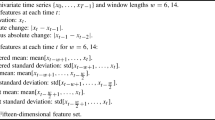Abstract
Markov regime switching (MRS) models successfully describe the cyclical behavior of time series by introducing hidden states and can better explain some stylised facts of asset returns. However, due to the complexity of the model, especially for multi-variate and multi-state cases, traditional maximum likelihood estimation (MLE) methods for MRS model suffers from strict assumptions and prone to converge to local optima. In this paper, we design a spectral clustering algorithm to predict hidden states of multi-variate MRS model by constructing feature vector and derive the parameter estimation. Monte-Carlo simulation results show that our algorithm is more robust than MLE. Meanwhile, we also give an application example of the algorithm by implementing a MRS asset allocation strategy in Chinese stock market.







Similar content being viewed by others
Notes
Transition matrix is Markovian matrix, whose row sum equals 1. Covariance matrix is positive definite.
The first eigenvalue of a Laplacian matrix is 0.
References
Aït-Sahalia, Y., Jacod, J., et al. (2009). Testing for jumps in a discretely observed process. The Annals of Statistics, 37(1), 184–222.
Aït-Sahalia, Y., Jacod, J., & Li, J. (2012). Testing for jumps in noisy high frequency data. Journal of Econometrics, 168(2), 207–222.
Albert, J. H., & Chib, S. (1993). Bayes inference via Gibbs sampling of autoregressive time series subject to Markov mean and variance shifts. Journal of Business & Economic Statistics, 11(1), 1–15.
Ang, A., & Bekaert, G. (2002). International asset allocation with regime shifts. The Review of Financial Studies, 15(4), 1137–1187.
Ang, A., & Chen, J. (2002). Asymmetric correlations of equity portfolios. Journal of financial Economics, 63(3), 443–494.
Ang, A., & Timmermann, A. (2012). Regime changes and financial markets. Annual Review of Financial Economics, 4(1), 313–337.
Bae, G. I., Kim, W. C., & Mulvey, J. M. (2014). Dynamic asset allocation for varied financial markets under regime switching framework. European Journal of Operational Research, 234(2), 450–458.
Bauer, R., Haerden, R., & Molenaar, R. (2004). Asset allocation in stable and unstable times. Journal of Investing, 13(3), 72–80.
Bhar, R., Malliaris, A. G., & Malliaris, M. (2015). The impact of large-scale asset purchases on the s&p 500 index, long-term interest rates and unemployment. Applied Economics, 47(55), 6010–6018.
Bulla, J. (2011). Hidden Markov models with t components. Increased persistence and other aspects. Quantitative Finance, 11(3), 459–475.
Bulla, J., Mergner, S., Bulla, I., Sesboüé, A., & Chesneau, C. (2011). Markov-switching asset allocation: Do profitable strategies exist? Journal of Asset Management, 12(5), 310–321.
Campbell, J. Y. (1999). Asset prices, consumption, and the business cycle. Handbook of Macroeconomics, 1, 1231–1303.
Chollete, L., Heinen, A., & Valdesogo, A. (2009). Modeling international financial returns with a multivariate regime-switching copula. Journal of Financial Econometrics, 7(4), 437–480.
Cochrane, J. H. et al. (2005). Financial markets and the real economy. Foundations and Trends® in Finance 1(1), 1–101.
Cont, R. (2001). Empirical properties of asset returns: Stylized facts and statistical issues. Quantitative Finance, 1(2), 223–236.
Dacco, R., & Satchell, S. (1999). Why do regime-switching models forecast so badly? Journal of Forecasting, 18(1), 1–16.
DeMiguel, V., Garlappi, L., & Uppal, R. (2007). Optimal versus Naive diversification: How inefficient is the 1/n portfolio strategy? The Review of Financial Studies, 22(5), 1915–1953.
Duan, J.-C., Popova, I., Ritchken, P., et al. (2002). Option pricing under regime switching. Quantitative Finance, 2(116–132), 209.
Elliott, R. J., & Siu, T. K. (2010). On risk minimizing portfolios under a Markovian regime-switching black-scholes economy. Annals of Operations Research, 176, 271–291.
Fawcett, T. (2005). An introduction to roc analysis. Pattern Recognition Letters, 27(8), 861–874.
Fonseca, J. D., & Wang, P. (2016). A joint analysis of market indexes in credit default swap, volatility and stock markets. Applied Economics, 48(19), 1767–1784.
Guidolin, M., & Hyde, S. (2012). Can var models capture regime shifts in asset returns? A long-horizon strategic asset allocation perspective. Journal of Banking & Finance, 36(3), 695–716.
Hamilton, J. D. (1989). A new approach to the economic analysis of nonstationary time series and the business cycle. Econometrica: Journal of the Econometric Society, pp. 357–384.
Hamilton, J. D., & Lin, G. (1996). Stock market volatility and the business cycle. Journal of Applied Econometrics, 11(5), 573–593.
Hardy, M. R. (2001). A regime-switching model of long-term stock returns. North American Actuarial Journal, 5(2), 41–53.
Hsu, D., Kakade, S. M., & Zhang, T. (2012). A spectral algorithm for learning hidden Markov models. Journal of Computer & System Sciences, 78(5), 1460–1480.
Ielpo, F. (2012). Equity, credit and the business cycle. Applied Financial Economics, 22(12), 939–954.
Jiang, P., Liu, Q., & Tse, Y. (2015). International asset allocation with regime switching: Evidence from the ETFs. Asia-Pacific Journal of Financial Studies, 44(5), 661–687.
Karolyi, G. A. (1995). A multivariate Garch model of international transmissions of stock returns and volatility: The case of the united states and canada. Journal of Business & Economic Statistics, 13(1), 11–25.
Kim, C.-J., Nelson, C. R., et al. (1999). State-space models with regime switching: Classical and Gibbs-sampling approaches with applications (p. 1). MIT Press Books.
Lo, A. W., & MacKinlay, A. C. (1990). Data-snooping biases in tests of financial asset pricing models. The Review of Financial Studies, 3(3), 431–467.
Lopes, A. S., & Zsurkis, G. F. (2019). Are linear models really unuseful to describe business cycle data? Applied Economics, 51(22), 2355–2376.
Ma, F., Lu, X., Yang, K., & Zhang, Y. (2019). Volatility forecasting: Long memory, regime switching and heteroscedasticity. Applied Economics, 51(37–39), 1–13.
Mulvey, J. M., & Liu, H. (2016). Identifying economic regimes: Reducing downside risks for university endowments and foundations. Journal of Portfolio Management, 43(1), 100–108.
Roncalli, T. (2013). Introduction to risk parity and budgeting. CRC Press.
Sheikh, A. Z., & Sun, J. (2012). Regime change: Implications of macroeconomic shifts on asset class and portfolio performance. Journal of Investing, 21(3), 36.
Siegel, J. J. (1991). Does it pay stock investors to forecast the business cycle? Journal of Portfolio Management, 18(1), 27.
Singh, V., & Roca, E. D. (2020). Weathering financial crisis in China: The role of global market integration. Applied Economics, 2020(1), 1–21.
Siu, T. K. (2012). A BSDE approach to risk-based asset allocation of pension funds with regime switching. Annals of Operations Research, 201(1), 449–473.
Tayal, A., Coleman, T. F., & Li, Y. (2015). Rankrc: Large-scale nonlinear rare class ranking. IEEE Transactions on Knowledge & Data Engineering, 27(12), 3347–3359.
Von Luxburg, U. (2007). A tutorial on spectral clustering. Statistics and Computing, 17(4), 395–416.
Wahab, M. I. M., & Lee, C. G. (2011). Pricing swing options with regime switching. Annals of Operations Research, 185(1), 139–160.
Wang, D., Ding, J., Chu, G., Xu, D., & Wirjanto, T. S. (2021). Modelling asset returns in the presence of price limits with Markov-switching mixture of truncated normal Garch distribution: Evidence from China. Applied Economics, 53(7), 781–804.
Zheng, K., Li, Y., & Xu, W. (2019). Regime switching model estimation: Spectral clustering hidden Markov model. Annals of Operations Research, pp. 1–23.
Acknowledgements
Zheng and Zhang gratefully acknowledges the financial support of the National Natural Science Foundation of China (No. 71671164). Xu gratefully acknowledges the financial support of the National Natural Science Foundation of China (No. 71771197). Zheng acknowledges the views expressed are solely those of the author and do not reflect the views of his employer, Moody’s Analytics, or its parent company, Moody’s Corporation or its affiliates.
Author information
Authors and Affiliations
Corresponding author
Additional information
Publisher's Note
Springer Nature remains neutral with regard to jurisdictional claims in published maps and institutional affiliations.
Rights and permissions
About this article
Cite this article
Zheng, K., Xu, W. & Zhang, X. Multivariate Regime Switching Model Estimation and Asset Allocation. Comput Econ 61, 165–196 (2023). https://doi.org/10.1007/s10614-021-10203-9
Accepted:
Published:
Issue Date:
DOI: https://doi.org/10.1007/s10614-021-10203-9




